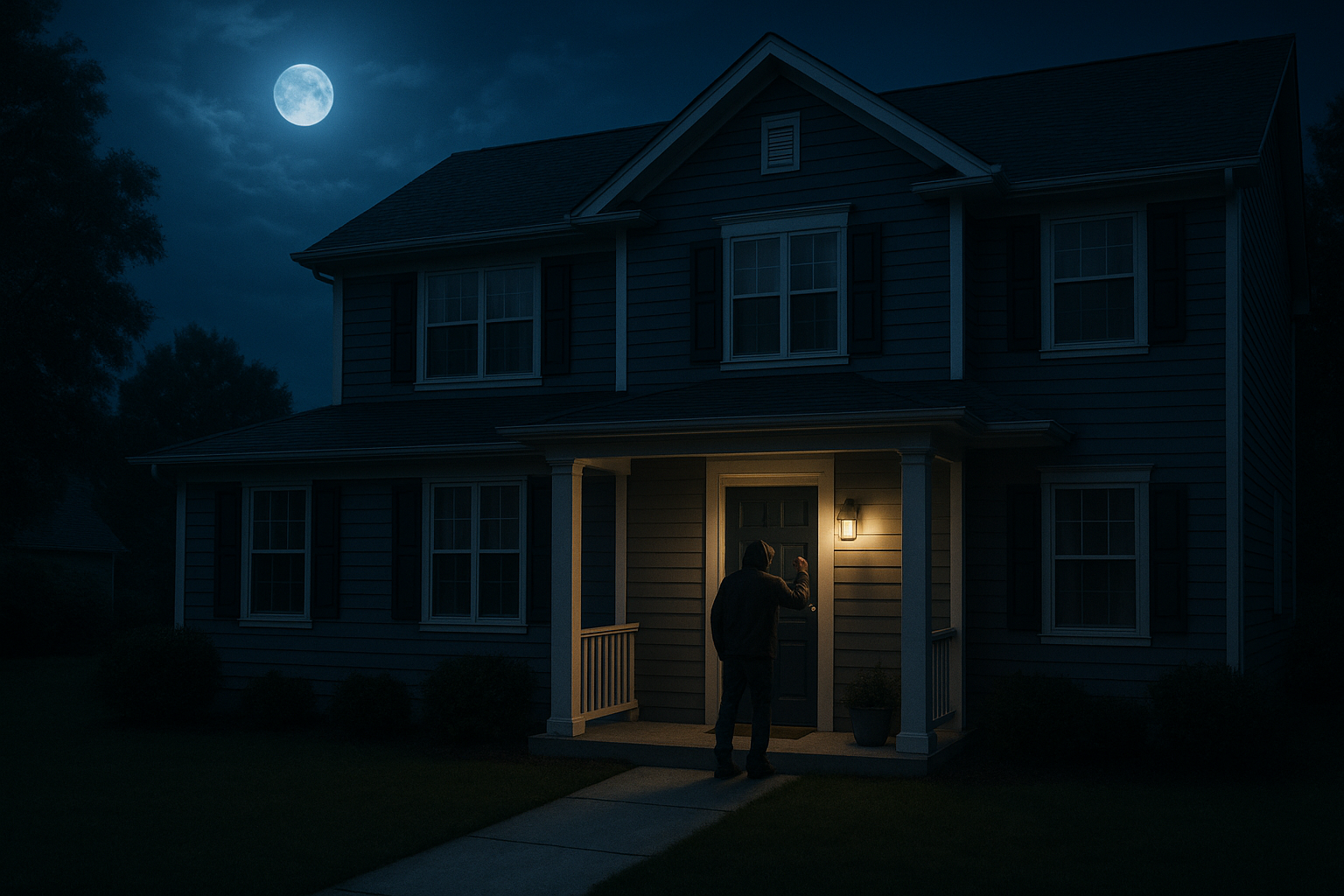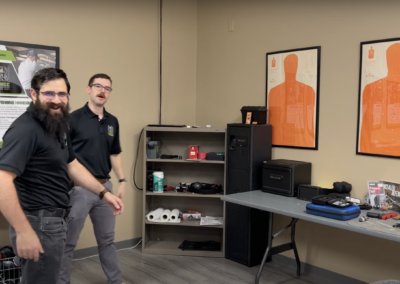The First 60 Seconds: Prioritizing Immediate Safety
When you hear that unexpected knocking, the first minute is crucial. Your actions in these initial moments set the tone for how the situation will unfold. Panic is your enemy; a calm, methodical approach is your greatest asset.
Here’s what to do immediately:
- Do NOT Open the Door: This is the golden rule. Opening the door immediately, especially without knowing who is on the other side, puts you at significant risk.
- Silence and Observe: Quietly move to a position where you can safely observe the door and any windows near the entrance. Avoid making noise or turning on bright lights that would reveal your presence.
- Alert Family Members: If you have family at home, quietly alert them to the situation. Instruct them to remain calm, stay away from windows, and if appropriate, move to a designated safe room.
- Arm Yourself (If Applicable): If you have a firearm or other defensive tool, retrieve it discreetly. Ensure it is ready for use, but keep it concealed. Your goal is not to provoke, but to be prepared to defend yourself if necessary. This is a core component of proactive home defense tactics.
Assess the Situation:
- Look through a peephole, security camera feed, or a secure window. Can you see who it is? Are they alone?
- Note any vehicles outside.
- Listen carefully. Are there voices? What are they saying? Is there more than one person?
Layered Home Defense: Fortifying Your Entry Points
Your home itself is your first line of defense. Implementing layered security measures can deter potential intruders and buy you precious time if someone attempts forced entry. Think of your home as an onion, with each layer providing additional protection.
Exterior Defenses: Deterrence and Detection
Before someone even reaches your door, several exterior measures can make your home less appealing to criminals:
Interior Defenses: Reinforcing Your Sanctuary
Even after a potential intruder gets past exterior defenses, your interior setup plays a vital role in your home defense tactics.
- Door and Window Reinforcement:
- Strike Plates: Replace standard strike plates with heavy-duty, four-screw versions that extend into the wall studs.
- Door Security Bars: For an extra layer of protection, especially on main entry doors, a door security bar can withstand significant force.
- Sliding Door Locks: Use a dowel or security bar in the track of sliding glass doors.
- Panic Buttons/Alarms: A silent alarm button connected to your security system can immediately alert authorities without escalating the situation verbally. Alarm systems can reduce the likelihood of a burglary by up to three times.
- Safe Room: Identify an interior room with a solid door, ideally with no windows, as a designated safe room. This is where your family can retreat if an intruder gains entry.
Responding Without Panic: Communication and Action
Once you’ve assessed the situation from a safe distance, it’s time to decide on your course of action. Your primary goal is to get the person to leave or to determine their intentions without putting yourself in harm’s way.
Non-Confrontational Communication:
- Speak Through the Door (If Necessary): If you cannot identify the person and they persist, speak firmly through the closed door. Do NOT open it.
- “Who is it?”
- “What do you want?”
- “I am not opening the door. State your business.”
- Use an Intercom System: If you have an intercom or video doorbell, use it to communicate. This keeps you even further removed from the immediate danger.
- Avoid Provocation: Do not engage in arguments or threats unless you are actively defending yourself from an imminent threat. Your goal is to deter, not to escalate.
When to Call for Help:
- Immediate Threat: If you suspect an attempted break-in, hear unusual noises, or see suspicious activity (e.g., someone trying to open windows), call 911 immediately. Emergency services response times can vary, with an average of around 7-10 minutes in many areas.
- Persistence: If the knocking or attempts to gain attention continue after you’ve spoken through the door or ignored them, it’s a sign of a potential problem. Call 911.
- Unusual Circumstances: Someone claiming to be a utility worker late at night without prior notice, or someone acting erratically, warrants a call to the authorities.
Remember: It’s always better to be safe than sorry. The police would rather respond to a false alarm than to a genuine emergency that could have been prevented.
Teaching Your Family How to Respond Without Panic
A crucial element of effective home defense tactics is ensuring that everyone in your household knows how to react calmly and correctly. Regular drills and open communication can significantly reduce panic during a real event.
Key Principles to Instill:
- “Never Open the Door to Strangers”: This rule should be reinforced from a young age.
- Designated Safe Zone: Everyone should know where the designated safe room is and how to get there quickly and quietly.
- Emergency Contact List: Keep a clearly visible list of emergency numbers (911, trusted neighbors, relatives) near landline phones and in an accessible location for older children.
- Communication Plan: Discuss what to do if parents are not home. Who should children call? What are the protocols for contacting each other?
- Practice Drills: Periodically, conduct practice drills for different scenarios, including someone at the door. This helps build muscle memory and reduces anxiety.
- Age-Appropriate Information: Tailor your discussions to the age and understanding of your children. Empower them with knowledge without instilling undue fear.
Essential Gear for Enhanced Home Security
While preparation and strategy are paramount, certain tools can significantly bolster your home defense tactics. This isn’t about creating an arsenal, but about having practical items that enhance your ability to respond effectively.
Home Readiness Kit Essentials:
- Personal Defensive Tool: This could be a firearm (if you are trained and legally permitted), pepper spray, a stun gun, or even a heavy-duty flashlight. Whatever you choose, ensure you are proficient in its safe and effective use. Approximately 32% of U.S. adults own a firearm.
- Bright Flashlight: A powerful tactical flashlight can disorient an intruder, allow you to navigate in the dark, and signal for help.
- Cell Phone (Charged): Keep your phone charged and accessible, ideally near your bed. It’s your primary communication tool. 97% of American adults own a cell phone.
- Portable Power Bank: For extended power outages or if your main power is cut.
- Whistle or Air Horn: A loud noise can startle an intruder and alert neighbors.
- First Aid Kit: For minor injuries that might occur during a stressful situation.
- Small Fire Extinguisher: For minor fires that might arise.
- Emergency Communications Device: A two-way radio (FRS/GMRS) for communicating with family members in different parts of the house if cell service is down.
Scenario Breakdown: A Step-by-Step Response
Let’s walk through a typical scenario to solidify these home defense tactics:
Scenario: You are asleep, and at 2:00 AM, loud, insistent banging starts on your front door.
Initial Reaction (First 15 seconds):
- Wake up immediately. Do not jump out of bed and rush to the door.
- Listen intently. Is it just one person? Is the knocking uniform or erratic?
- Silently alert your partner/spouse.
Assessment and Preparation (Next 45 seconds):
- Quietly get out of bed. Avoid turning on lights immediately.
- Retrieve your defensive tool (e.g., firearm, pepper spray) and a bright flashlight. Keep them low and out of sight.
- If applicable, instruct family members to move to the safe room.
- Creep to a vantage point near the front door, away from any windows, where you can safely observe through the peephole or security camera.
Observation (Next 1-2 minutes):
- Look through the peephole or check your security camera feed.
- Can you see who it is? Are they alone? Is there a vehicle?
- Are they attempting to open the door, or just knocking?
- Listen for voices or other suspicious sounds.
Decision and Action:
- If you recognize the person (e.g., neighbor in distress): Exercise extreme caution. Verify their identity verbally through the door. “John, is that you? What’s wrong?” If it’s a true emergency, call 911 first, then consider a safe way to assist under police guidance. Do NOT open the door if you feel unsafe or unsure.
- If you do NOT recognize the person, or they seem suspicious:
- Do NOT open the door.
- Call 911 immediately. Give the dispatcher your address, describe the situation (unidentified person banging on your door), and any observations (e.g., “one male, dark clothing, no vehicle seen”).
- Speak through the door (optional, but recommended): While on the phone with 911, you can firmly say, “I am calling the police. Leave now.” This lets them know you are aware and taking action. Do not engage in further conversation.
- Maintain defensive posture: Keep your defensive tool ready but concealed. Keep your flashlight off unless you need to temporarily disorient an intruder if they gain entry.
- Stay in a safe, defensible position until law enforcement arrives. Do not approach windows or place yourself in a vulnerable position.
Post-Event:
- Once law enforcement arrives, follow their instructions carefully.
- Provide them with all the information you gathered.
- Assess your home security. Were there any vulnerabilities exposed? What can you do to improve your home defense tactics?
The Prepared Mindset: Confidence Through Preparedness
The most effective home defense tactics aren’t just about gear or physical barriers; they’re about cultivating a prepared mindset. This involves proactive planning, regular practice, and a commitment to personal and family safety. When you know what to do, you replace fear with confidence and chaos with control.
Being prepared empowers you to be resilient, not just reactive. It allows you to face unexpected challenges with a clear head and decisive action. Studies show that people who have a plan for emergencies experience less stress and better outcomes. Start today by reviewing your current home security, discussing these scenarios with your family, and acquiring the knowledge and tools that will make your home a safer, more secure sanctuary. Your peace of mind and the safety of your loved ones are worth the investment.





0 Comments